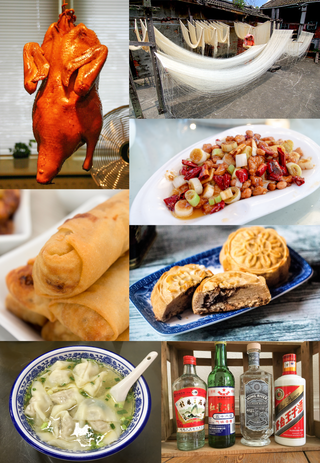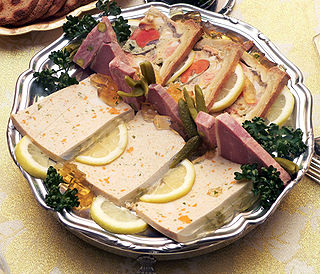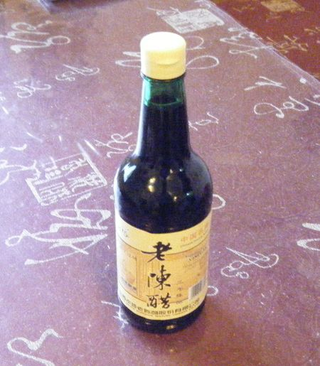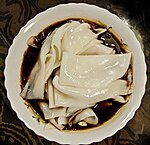
Cantonese or Guangdong cuisine, also known as Yue cuisine, is the cuisine of Cantonese people, associated with the Guangdong province of China, particularly the provincial capital Guangzhou, and the surrounding regions in the Pearl River Delta including Hong Kong and Macau. Strictly speaking, Cantonese cuisine is the cuisine of Guangzhou or of Cantonese speakers, but it often includes the cooking styles of all the speakers of Yue Chinese languages in Guangdong.

Chinese cuisine comprises cuisines originating from China, as well as from Chinese people from other parts of the world. Because of the Chinese diaspora and the historical power of the country, Chinese cuisine has profoundly influenced many other cuisines in Asia and beyond, with modifications made to cater to local palates. Chinese food staples such as rice, soy sauce, noodles, tea, chili oil, and tofu, and utensils such as chopsticks and the wok, can now be found worldwide.

Shanghai cuisine, also known as Hu cuisine, is a popular style of Chinese food. In a narrow sense, Shanghai cuisine refers only to what is traditionally called Benbang cuisine which originated in Shanghai. In a broader sense, it refers to complex styles of cooking developed under the influence of neighboring Jiangsu and Zhejiang provinces.

Offal, also called variety meats, pluck or organ meats, is the internal organs of a butchered animal. The word does not refer to a particular list of edible organs, and these lists of organs vary with culture and region, but usually exclude skeletal muscle. Offal may also refer to the by-products of milled grains, such as corn or wheat.
Sweet and sour is a generic term that encompasses many styles of sauce, cuisine, and cooking methods. It is commonly used in East Asia and Southeast Asia and has been used in England since the Middle Ages. Sweet and sour sauce remains popular in Asian and Western cuisines.
Romanian cuisine is a diverse blend of different dishes from several traditions with which it has come into contact, but it also maintains its own character. It has been influenced mainly by Turkish but also a series of European cuisines in particular from the Balkan Peninsula and Hungarian cuisine as well as culinary elements stemming from the cuisines of Central Europe.

Northeastern Chinese cuisine is a style of Chinese cuisine in Northeast China. While many dishes originated in Shandong cuisine and Manchu cuisine, it is also influenced by the cuisines of Russia, Beijing, Mongolia, and North Korea. It partially relies on preserved foods and large portions due to the region's harsh winters and relatively short growing seasons.

Pancit, also spelled pansít, is a general term referring to various traditional noodle dishes in Filipino cuisine. There are numerous types of pancit, often named based on the noodles used, method of cooking, place of origin or the ingredients. Most pancit dishes are characteristically served with calamansi, which adds a citrusy flavor profile.

Japanese Chinese cuisine, also known as chūka, represents a unique fusion of Japanese and Chinese culinary traditions that have evolved over the late 19th century and more recent times. This style, served predominantly by Chinese restaurants in Japan, stands distinct from the "authentic Chinese food" found in areas such as Yokohama Chinatown. Despite this difference, the cuisine retains strong influences from various Chinese culinary styles, as seen in the shippoku cooking style.

Hubei cuisine, also known as Chu cuisine or E cuisine, is derived from the native cooking styles of Hubei Province in China.

Shaanxi cuisine, or Qin cuisine, is derived from the native cooking styles of Shaanxi Province and parts of northwestern China.

Black vinegar is dark-colored vinegar traditionally used in Chinese and other East Asian cuisine.

Bavarian cuisine is a style of cooking from Bavaria, Germany. Bavarian cuisine includes many meat and Knödel dishes, and often uses flour. Due to its rural conditions and Alpine climate, primarily crops such as wheat, barley, potatoes, beets, carrots, onion and cabbage do well in Bavaria, being a staple in the German diet.

Pork blood soup is a soup that uses pork blood as its primary ingredient. Additional ingredients may include barley and herbs such as marjoram, as well as other foods and seasonings. Some versions are prepared with coagulated pork blood and other coagulated pork offal, such as intestine, liver and heart.

Wonton noodles is a noodle dish of Cantonese origin. Wonton noodles were given their name, húntún, in the Tang Dynasty. The dish is popular in Southern China, Hong Kong, Indonesia, Malaysia, Singapore, Vietnam and Thailand. The dish usually consists of egg noodles served in a hot broth, garnished with leafy vegetables and wonton dumplings. The types of leafy vegetables used are usually gai-lan, also known as Chinese broccoli or Chinese kale. Another type of dumpling known as shui jiao (水餃) is sometimes served in place of wonton. Shrimp wonton are mostly known as Hong Kong dumplings. The wontons contain prawns, chicken or pork, and spring onions, with some chefs adding mushroom and black fungus. In Indonesia especially in North Sumatra, West Kalimantan and South Sulawesi, wonton noodles are called mie pangsit.

Mì (mỳ) or mi is a Vietnamese term for yellow wheat noodles. It can also refer to egg noodles. They were brought over to Vietnam as wonton noodles by Chinese immigrants. The Vietnamese version of wonton noodles is mì hoành thánh. The noodles can be either thin or wide and are commonly used in súp mì and mì khô.

Gansu cuisine, also known as Long cuisine (陇菜), is the regional cooking style of the Han Chinese deeply influenced by the local Hui people in the Gansu province of Northwestern China.

Shanxi mature vinegar is a type of Chinese vinegar. It is a product of Shanxi Province.



















